See also
Anabaptist
Anglican
Lutheran
- First Lutheran hymnal
- Erfurt Enchiridion
- Eyn geystlich Gesangk Buchleyn
- Swenske songer eller wisor 1536
- Thomissøn's hymnal
Presbyterian
Reformed
The Souterliedekens (literal: Psalter-songs) is a Dutch metrical psalter, published in 1540 in Antwerp, and which remained very popular throughout the century. The metrical rhyming psalms were, probably, arranged by a Utrecht nobleman: Willem van Zuylen van Nijevelt (d. 1543). For the melodies he used folksongs from the Low Countries (though some have German or French origin). This publication has great value, because the publisher (Symon Cock) not only added the phrase 'sung to the tune of...' but also provided the actual music (melody) with the texts.
Nowadays many of the folksong melodies that were known at that time can only be reconstructed because they have survived in the "Souterliedekens". Composers like Jacobus Clemens non Papa, Gerardus Mes, and Cornelis Boscoop made polyphonic settings based on the melody of the monophonic "Souterliedekens". The melody often functions as a cantus firmus. The Antwerp printer Tielman Susato dedicated four volumes of his music-books ("Musyck Boexkens") to Clemens' "Souterliedekens" (vol. IV to VII).
Anabaptist
Anglican
Lutheran
Presbyterian
Reformed

A hymnal or hymnary is a collection of hymns, usually in the form of a book, called a hymnbook. They are used in congregational singing. A hymnal may contain only hymn texts ; written melodies are extra, and more recently harmony parts have also been provided.
Jacobus Clemens non Papa was a Netherlandish composer of the Renaissance based for most of his life in Flanders. He was a prolific composer in many of the current styles, and was especially famous for his polyphonic settings of the psalms in Dutch known as the Souterliedekens.

Christian music is music that has been written to express either personal or a communal belief regarding Christian life and faith. Common themes of Christian music include praise, worship, penitence and lament, and its forms vary widely around the world. Church music, hymnals, gospel and worship music are a part of Christian media and also include contemporary Christian music which itself supports numerous Christian styles of music, including hip hop, rock, contemporary worship and urban contemporary gospel.
"Old 100th" or "Old Hundredth" is a hymn tune in long metre, from the second edition of the Genevan Psalter. It is one of the best known melodies in many occidental Christian musical traditions. The tune is usually attributed to the French composer Louis Bourgeois.

A metrical psalter is a kind of Bible translation: a book containing a verse translation of all or part of the Book of Psalms in vernacular poetry, meant to be sung as hymns in a church. Some metrical psalters include melodies or harmonisations. The composition of metrical psalters was a large enterprise of the Protestant Reformation, especially in its Calvinist manifestation.
Decisions concerning the conduct of public worship in the Church of Scotland are entirely at the discretion of the parish minister. As a result, a wide variety of musical resources are used. However, at various times in its history, the General Assembly has commissioned volumes of psalms and hymns for use by congregations.

The Genevan Psalter, also known as the Huguenot Psalter, is a 1539 metrical psalter in French created under the supervision of John Calvin for liturgical use by the Reformed churches of the city of Geneva in the sixteenth century.
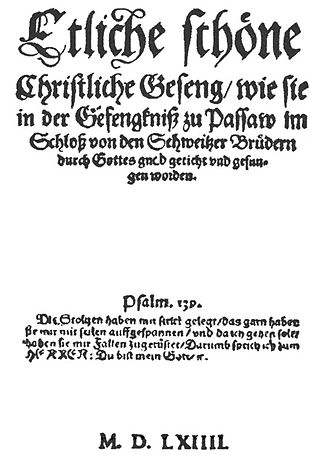
The Ausbund is the oldest Anabaptist hymnal and one of the oldest Christian song books in continuous use. It is used today by North American Amish congregations.
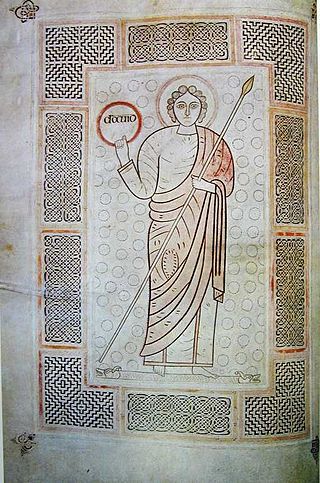
Psalm 100 is the 100th psalm in the Book of Psalms in the Tanakh. In English, it is translated as "Make a joyful noise unto the Lord, all ye lands" in the King James Version (KJV), and as "O be joyful in the Lord, all ye lands" in the Book of Common Prayer (BCP). Its Hebrew name is מִזְמוֹר לְתוֹדָה, 'Mizmor l'Todah' and it is subtitled a "Psalm of gratitude confession". In the slightly different numbering system in the Greek Septuagint version of the Bible, and in the Latin Vulgate, this psalm is Psalm 99. In the Vulgate, it begins Jubilate Deo, or Jubilate, which also became the title of the BCP version.
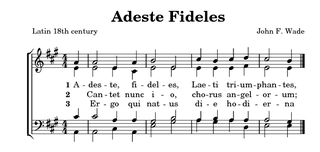
A hymn tune is the melody of a musical composition to which a hymn text is sung. Musically speaking, a hymn is generally understood to have four-part harmony, a fast harmonic rhythm, with or without refrain or chorus.
Gerardus Mes or Gherardus was a Franco-Flemish composer.
Rhymed psalters are translations of the Psalms from Hebrew or Latin into poetry in some other language. Rhymed psalters include metrical psalters designed for singing, but are not limited to that use.

"The Lord's My Shepherd" is a Christian hymn. It is a metrical psalm commonly attributed to the English Puritan Francis Rous and based on the text of Psalm 23 in the Bible. The hymn first appeared in the Scots Metrical Psalter in 1650 traced to a parish in Aberdeenshire.
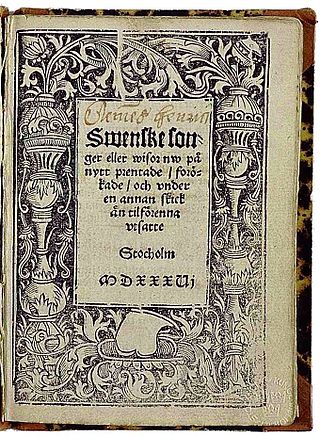
Swenske songer eller wisor nw på nytt prentade / forökade / och under en annan skick än tilförenna utsatte, often abbreviated as just Swenske songer eller wisor 1536, is the first preserved hymnal published in the Swedish language and was released in 1536. It consists of 47 songs or hymns, all of which have been issued anonymously. Olaus Petri, a major contributor to the Protestant Reformation in Sweden, is however believed to have authored most of them, with contributions from Ericus Olai and Laurentius Petri. A large amount are translations of Latin and German hymns.

The First Lutheran hymnal, published in 1524 as Etlich Cristlich lider / Lobgesang und Psalm, often also often referred to as the Achtliederbuch, was the first Lutheran hymnal.

The Erfurt Enchiridion is the second Lutheran hymnal. It appeared in 1524 in Erfurt in two competing editions. One of them contains 26 songs, the other 25, 18 of them by Martin Luther, others by Elisabeth Cruciger, Erhard Hegenwald, Justus Jonas and Paul Speratus. While the songs of the Enchiridion could be used in churches, they were intended primarily for singing elsewhere, such as at home, at court, and in guild meetings.
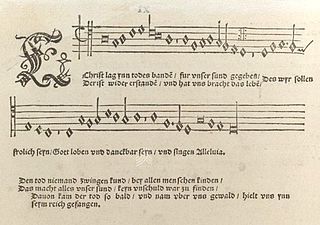
Eyn geystlich Gesangk Buchleyn, was the first German hymnal harmonised for choir, published in Wittenberg in 1524 by Johann Walter who collaborated with Martin Luther. It contains 32 sacred songs, including 24 by Luther, in settings by Walter for three to five parts with the melody in the tenor. Luther wrote a preface for the part books. The collection has been called the root of all Protestant song music.

Thomissøn's hymnal was a hymnal published in Denmark that received royal authorization in 1569.
Church music during the Reformation developed during the Protestant Reformation in two schools of thought, the regulative and normative principles of worship, based on reformers John Calvin and Martin Luther. They derived their concepts in response to the Catholic church music, which they found distracting and too ornate. Both principles also pursued use of the native tongue, either alongside or in place of liturgical Latin.